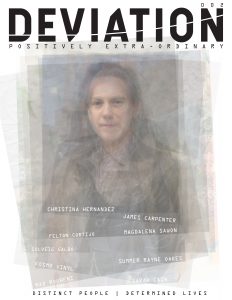Magdalena Sawon Is Interested
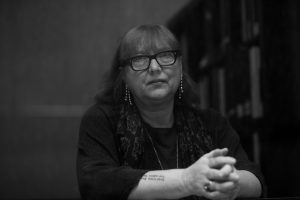
Photo by Nathan Rocky @nathanrocky
By Ash Hoden
It was a discovery, even though I was looking for it. While scouring the streets of Manhattan, a total outsider to the city’s art scene on a quest to write about the people in that scene, I encountered a simple black and white banner that said Postmasters Gallery. It was pinned to construction scaffolding near two understated, residential-looking doors. A plywood interior wall obstructed the view through the bottom half of the gallery’s front windows, above which a flatscreen displayed an image of a shadowy man standing in a street. The caption “…Art is lost in this town…” was stamped along the bottom of the frame. Despite my lack of familiarity with the terrain I knew enough to recognize an outlier. Inside was Magdalena Sawon, one of the gallery’s founders.
I have a thing for those who are perpetually reborn — year after year, decade after decade. These individuals navigate education systems, employers, police and courts, families, neighbors, or the great mass of people and institutions who enforce the tyranny of mediocrity, and in the face of constant pressure refuse to fall in line. From beginning to end they remain fresh and engaged and curious. It is a victory. They win because the uncorrupted are ageless, and it’s that ageless quality that fascinates me.
I understand the refusal to trade the unknown for security, or to let comfort stagnate progress and a life of constant exploration. But how does one protect that inner voice, trusting it to lead the way even when it demands that you risk everything in the process — year after year after year? I long to know the secret. Is it strictly a matter of remaining curious? Are the Steinems and Cohens of the world simply more curious? Does curiosity alone explain the unceasing need to explore and represent the fringe before it is engulfed by the ever-expanding center? Then finding and exposing a new fringe, and on and on. Is this willingness to take risks simply a factor of curiosity? Or is the fountain of youth a more varied and nuanced phenomenon? I do not know.
Whatever it is, Magda has it. She’s tall and fashionable, possessing an urban style that’s both edgy and mature. Her fiery orange hair stands in perfect contrast to her black glasses, dark clothes, and thick-soled black boots. She’s both hip and original, speaking coolly and candidly about establishing Postmasters in the 1980s and her life spent in pursuit of the frontiers:
“I come from Poland. I was born in Warsaw and I came to the states in 1981. At this point I live here longer than I live there. So, how do you negotiate who you are and where you are from? It’s a larger issue.”
I understand how that is. ‘Are you American or are you Polish or are you somewhere in the middle?’ In the end it’s kind of both.
“It’s both and it’s fluid. It changes. Sometimes you dream in the old language, sometimes you count in the old language, and then comfort with speaking English is gradually progressing. But I don’t have any particular nostalgia towards where I come from.”
What brought you here?
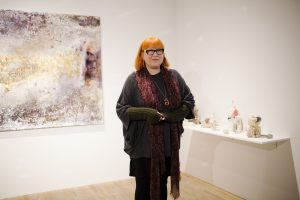
Photo by Nathan Rocky @nathanrocky
“I graduated from the department of art history, so I have this very proper art historical degree. The typical path at that point is to be an academic, and that was not very interesting for me. My interest was always to apply that knowledge or that type of education towards contemporary art. That’s the top of the passion that I would have. And this was still a communist time in Poland — mid-70s, early-70s. Not only the art history education did not include contemporary art or art of living artists, the definition of art history was a true definition of history — done, gone, everybody dead. Whereas right now the people that graduate from art history are perfectly involved in contemporary art. That was my agenda. I did want to be involved in contemporary art rather than historical art. At that time in Poland that was maybe not realistic because obviously all the galleries were not private. One would have to be involved with some sort of government agency or be sponsored by this or that ministry, and that takes away certain creative freedoms that you can have. They can tell you, ‘Well, next month you’re going to do a show of photographs from Azerbaijan.’ And that’s what I’m going to do because it’s not a choice situation. That’s why I came here. My mother was already in Chicago, so that path was quite easy for me. She came when I was eighteen or seventeen. At that point getting the passport was an operation. You either got it or you didn’t get it. You submit, you wait three months, then you go to the office and they either give it to you or it says, ‘For social reasons.’ This was the phrase that would be used when they refuse you the passport.”
Refused for social reasons.
“And that is an impenetrable concept because that could be anything. So my situation was that she was here, I could go visit — I think it was two times prior that I visited and returned, so my track record was very positive. They gave me the passport, I went for my trip, I came back. They gave me the passport again, I went for my trip, I came back. So when I graduated and I decided that this is the time to go, I got this passport for this last time and that was the time when I just did not come back.”
Did you have to keep it secret — not telling friends or family?
“Not necessarily. You sort of trust your friends, perhaps not always within this semi-aggressive communist system. But I think the 70s were already past this early communist system where you look around behind your back who can be an informant. And it just wasn’t a big enough case to go and not return. The people that were my friends, or associates, and my family — I think they were perfectly aware of the fact that I’m just gone at that point.”
The government wasn’t interested in contemporary art?
“No, they were interested. Culture in Poland and artists and people around art did have a certain degree of freedom from censorship because it was the cultural export of Poland; something of a big pride for the government. Polish theater, Polish art, Polish posters, Polish film — these were points that the country was proud of. They weren’t that proud of their miners, because there is a lot of coal digging in Poland. But this was something positive. On many levels people like me and people around culture were quite privileged. But still, it was unpredictable to what degree one could do what you would want to do creatively with the concept of “contemporary art gallery.” This model did not really exist. That was one thing. And the other thing — my interest was always to go to the center of activity. There’s this saying, I think even in English, of big fish in a small pond or small fish in a big pond. I much prefer the second model. New York is a very active place and there’s art and artists and creative energies, but it’s very different than years ago where this was the place, and not so many others. Right now these planes are much more even. It’s not just New York, London, Paris. The gallery is a reflection of that. We show artists from everywhere. We show artists of any color, any gender, any in-between gender… If you deal with contemporary work and your effort is to reflect that culture, it has to reflect that culture. It’s not the white people’s world that sit on top of everything — this Western model in which there’s such a hierarchy. But at my time, coming back to this provincial idea, I think Poland was fascinating but it still was peripheral. At that point I perceived New York as the center — kind of a beehive of what’s going on.”
So you really wanted to get here?
“I really wanted to be here. And my mother was in Chicago so initially I went to Chicago. I managed to be there for three weeks, which, I don’t think reflects poorly on Chicago. But at that point she was very ensconced in a Polish community. The Polish community of Chicago is like a million people, but a lot of it is not incredibly interesting. It’s like basic economic immigration. It’s not about climbing. It’s not about integration. It’s not about curiosity. It’s more about survival instincts — surrounding yourself with people like you. You didn’t even have to speak English because there was a Polish butcher and Polish driving school and Polish doctors and dentists. This infrastructure was there. It was somewhat oppressive. They expected you to be with them. If you want out it’s not looked upon in a great way.”
Did you always have this curiosity to expand and see more?
“Yeah. I mean, I grew up with certain degree of cultural privilege because my family and my immediate circle of people were very much involved in culture, and very traveled. It was also an intellectual circle of people, so whomever traveled they brought information. They would go to West Berlin and bring forbidden books and avocado and red socks. You had this mixture of being there but also being able to collect and reflect information from outside. Some of it was coming in natural channels and some of it was coming in different ways. My father was a mathematician. He went to teach in Vienna and I told him to bring me David Bowie records, and he did. It was this privilege to a certain degree — being informed about the outside.”
Your parent’s encouraged it?
“My parents didn’t necessarily care so much. My dad was a mathematician in the highest level of abstract mathematics. Just pure theory. His social skills and engagement with other people were fairly diminished, so we didn’t have that much normal communication. If I was a mathematician maybe we would be better friends, but the field of my interest in no way correlated to him. His hierarchy of how good a person can be had so much to do with what you do. When I came here, in order to survive I worked selling shoes at a very high fashion store. For him that was an abomination. ‘How can a person who comes from all these degrees and intellectual luxury — how can you lower yourself to go somewhere and just be on this level of survival? You could be professor at the university in Poland?’ It was a big gap of what his ideas were and what mine were, and are. And my mom, she left early on. So I don’t really have that relationship.”
So there was freedom and space to explore?
“I was very much on my own. Those are situations that it totally depends on the person. If you have no guidance and you don’t have a structure around you, a person can derail very easily. Or, be just completely free to do whatever the fuck you want. I was very lucky. It fit my DNA — this idea that there was nobody around and I could do what I wanted.”
What kind of things were you getting into at that point?
“Between a typical Polish drinking and partying, I was primarily a kind of adoptive child of different friend’s families. I managed to be very socially engaged with many different people.”
Here in New York?
“Before that. Then, once I arrived here after being in Chicago those few months, that was also the big point of integrating into whatever is going on. That was interesting because if you come from a large community of immigrants, people perceive you as such. A single person in a very different circle functions as a Polish person with a weird accent. The exoticism of that is a very positive thing. It’s a funny dynamic. When I came here and I didn’t know the next Polish person, all these contacts you make are interesting because in many instances people appreciate difference. New York is also incredibly specific to that because there’s such a wide range of people here. They come from everywhere, and everywhere means Poland, it means Kansas, and it means Madagascar. It’s this special place. It’s so big that one way or the other you manage to negotiate your way into one, two, or three people that you know. Through them it’s rhizomatic to other people. But on the other hand it can be unbelievably overwhelming. You come to this city without knowing many people. Basically you don’t know 12 million people. It’s scary. I remember this one point for me that was almost a trigger for comfort. I was walking through 8th Street in the village and I saw somebody that looked very distinctive. Then two weeks later I saw the same person. That kind of shrinks this notion of unbearable and inhuman largeness of a place.”
The idea that you’d see the same person twice. Did it take long to recognize the difference between how you were received when you were with the Polish community and how you were received on your own?
“I was hoping for that. And when you’re 20 it’s a very kamikaze time in life. People are fearless. A lot of things, when you do without knowing are the best things because you are fearless. Even in this parallel of galleries. It’s very different when you come up with this idea of opening a gallery and don’t have a clue. Versus these people that do the apprenticeship and they went to special school and they worked for a bigger gallery and then they collected all the information and then eventually they opened their own. It was interesting to come here and have this always on the top of my head — this idea that I just completely want to be involved in contemporary art and in current things — and not exactly knowing how to go about it.
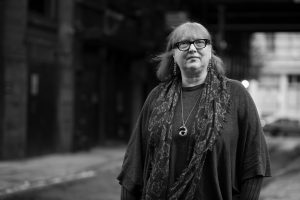
Photo by Nathan Rocky @nathanrocky
“So I went about it the same way as anybody else would. You make your list. ‘What’s your favorite thing to do? I want to work at Castelli gallery.’ You go there and there’s no job. And at some point I was recommended to go to Tibor de Nagy gallery. This was a gallery that was at that point still flaming with being important — quite involved in the 60s with the top moment of American art. When I was there it was already after that. Probably if I pressed harder I would get a job there, but I didn’t want to. It’s this egomaniacal idea of a young person. ‘This is not good enough.’ But the reality of it was that I had all these degrees but my language skills were not very good. What positions would be available for me to start with the galleries were the positions that were borderline receptionist/secretarial. I had master degrees but I didn’t have language skills to answer the phone, so this gap was not very good.
I know it’s maybe an impossible question to answer, but if you had the language skills to land a job in one of the galleries from the beginning do you think that you would have started Postmasters?
“I don’t know. I could probably be a tragically boring-life-living person. But it’s not just language. It’s like, not fitting into pre-established things. I think there was more to it than just communication skills. There’s a larger picture and then there’s a very small picture. For example, Russian is not a favored language in Poland because it was an oppression of the communists and you were forced to learn and all that. It just so happens that in my school the teacher who was teaching Russian was this incredible person and it was a joy to learn. You learn Lermontov and Pushkin and if she gives love to this language and somehow breaks this barrier of discomfort and hatred and historical irritation that you have… I was very lucky. I learned from the good one.”
We return to the topic of Magda’s job at Henri Bendel’s shoe boutique:
“At that point it was this jewel of higher fashion. From Cher to Jackie Kennedy and a lot of collector ladies. So that was very interesting because, in a way, from the position of a servant you have contact with all these interesting people. One of the women that was buying shoes there was Estelle Schwartz — one of the top art consultants. She was running an art class at New School, basically for rich wives. Every semester she had this class where 30 or 20 ladies from higher ends of society would come. The idea was that she would take them to galleries to show what kind of art is being made, and to buy even.
“So I took that course and I was an imposter there. The benefit of that was that she actually was quite incredible in preparing materials — giving a lot of information for people to read and know. And she had great access because she was bringing what was perceived as potential clients. That was the way I went to Patti Astor gallery and I saw Jean Michel Basquiat paintings that were possible to buy for $2000. Which I didn’t have. Then I went to the back room of Castelli and the back room of Mary Boone and the back room of Sonnabend, and you just kind of sponge.”
And you met people through that?
“I met some people through that, but it was more about seeing those top notch galleries and the material that was the most of-the-moment materials, and have these people tell you about it. I remember I saw the very first show of the artist Terry Winters at Sonnabend gallery. Not even the show but they took us to the back room and we saw these paintings. This was amazing thing. Very, just a chance in life. And this gives you information and gives you certain energy and kind of assures you more, ‘Do you want to do that, or you don’t want to do that?’”
You were really looking for that education in contemporary art?
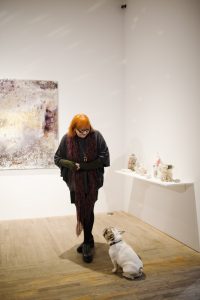
Photo by Nathan Rocky @nathanrocky
“That was like ’81, ’82, ’83. Those were the years I was looking for that. Then I met Tamas [Banovich], my partner of 30-something years. He’s Hungarian and we met through some friends here in New York. That was also the moment when the art scene in East Village was starting to happen. When you could really open a gallery with neither money nor experience. A lot of club kids and artists and people like us were opening their galleries in little store fronts for a couple of thousand dollars. And nobody had a clue about the market, how you invoice people… Everybody was more interested in this participatory nature; being a part of the moment. By December 1984 we opened the gallery in East Village on Avenue A, and were there for like five years. Then moved to Soho for ten years and then to Chelsea for fifteen years and then here. We are kind of experimental rabbits that reflect the pattern of how the art world moved in these years. Because these scenes were being born and collapsing, like in the East Village. After five years the club kids sort of dropped out and some of the artists that were running galleries also dropped out because they had their own careers. I think there are two or three galleries that still exist from that time.
“That scene died out and the majority of those galleries moved to Soho, which was a very established art scene. It wasn’t kindergarten art. The big guys were there. And after all these years in the East Village and having some degree of influence of how people perceived what’s interesting in art, it was a good moment to move to the bigger pool — kind of stake your territory with all these other galleries. We lasted ten years there and that was another scene that was over-gentrified. Then a lot of people from Soho moved to Chelsea in its very early moment. I was there in ’98. It was still just a handful of places and a lot of empty parking lots and garages. That was the scene. In the course of fifteen years obviously this whole thing exploded and changed.”
You worked maybe two years selling shoes and went directly into having a gallery? That’s amazing.
“Well, somebody became this silent partner in the gallery for very little money. That person helped us to set it up. Then, yeah, we did that. But it was this spectacular moment that this was actually possible.”
Since there were a lot of people that have done similar and weren’t able to make it, do you feel like there was something specific about how you went about business to survive?
“Well I think some of it perhaps has to do with, these are all cliches, but there is this Eastern European drive. Where I come from it’s not business. You just do a lot of very kamikaze things rather than having this proper, ‘Oh, it’s not working. There’s a downturn. Let’s do something else.’ Between this attitude and the true passion — we really like doing it, and you do it for the artists and you do it for being a part of this culture rather than to buy yourself a Cadillac. Another aspect of it is this paradoxical thing. The longer you stick with it the more unemployable you become. I can’t imagine working for people.”
I completely relate.
“It’s a very funny situation. Your skills improve, your knowledge improves, your experience improves, and yet, you can’t work for anybody. It’s a very funny place — how it is. And we never grew huge. I mean, this is substantial but it still is a very small organization which we can expand and contract depending on the condition. We went through all these circles of economic upturn, downturn, upturn, crash, downturn. It’s small enough not to fit in these larger patterns and it’s big enough to be noticed. We have this very funny position in the art world where the gallery is somewhat unique, because what drives us is this huge passion rather than the market forces to a large degree. We do things that a sane person with the perfect idea of how the market operates would not touch.”
How so?
“Well, because it’s a money losing proposition to show a lot of contemporary art. What sells is not necessarily what’s interesting. I have to negotiate that because very often what sells is interesting art. But there’s so much really interesting art for which the market does not exist. And often I would say it does not exist yet. Because we have this — you can’t call it a sixth sense or anything anticipatory — but if you are there early you pick things up early.”
You have a feel for the culture—
“Art and artists. Yeah. When it’s at this beginning stage it’s at the tip of the nerve. It was 1996 for example when Tamas and I had this show called Can You Digit?. It was a show of purely screen-based artwork. It’s in history books right now but at that point people were like, ‘What the fuck?’ We had a very specific way of attempting to present this new new form of expression; this medium. And tried to present it at the same place as the traditional forms of painting, sculpture, dah dah dah would be. So, yes, we obviously are in the business model. We obviously want to survive. But at the same time there is this continuous curiosity to look for the new things and to locate what may possibly be interesting. The longer you do it and the more visible the gallery is, to some degree, is a little bit easier. People trust you more because there is a track record. ‘Oh yeah, these people know what they are talking about because they always have a good sense of what’s at the very forefront of creative thinking.’”
Do you get a negative response sometimes, like with Can You Digit?
“Oh yeah! We lost collectors from that because software-based and screen-based work flies in the face of traditional medium which people want to collect that is all tangible and material and not migrating technologically. There was a lot of people that were not into it because it’s unfamiliar. The way the art market is established these are still complete peripheries. 90% of the market is paintings. And occasional sculpture and some photographs. But all the new formats, all the emerging fields, they don’t fit there. On the other hand an argument could be made that a lot of that stuff is a much truer reflection of the culture. Of this moment.
“So how do you negotiate that? That’s my whole job. I’m not against traditional media, but within those more traditional formulas you still have to deliver new ideas. Something that is relevant to now. I always have this idea that there has to be a time stamp in the world. ‘Why is it something that is being made now? Why wasn’t it possible to make it twenty years ago?’ Some of that answer is technological progress. Some of that answer is just factual development of world and history. And some of that answer is individual people figuring out crazy things that nobody thought about before. If I’m living in 2017, I want to understand this time and see what’s going on and what’s the context. This is the interesting problem of art history — that not often is art history read in the larger historical context. People get narrowed down. A larger context of the world is reflected in the art. Sometimes it’s reflected by direct content. The work refers to events and situations and ideas that are developed of the moment. Sometimes it’s a rejection of that moment, right. There’s war, there’s horrible things happening, so they paint transcendent paintings. It goes both ways. The interesting thing is to recognize that and to understand. That level of multi-dimensional thinking is really important.
“So here in the gallery we don’t have an aesthetic. A lot of galleries you can easily recognize. ‘Oh, they are interested in abstract painting or they are interested in very aggressive aesthetic or they are interested in very neutral aesthetic or they are interested in this medium.’ I don’t know what this gallery is for. Whatever we see tells me what it’s for. Some of it is instinctual and some of it is this desire to see and learn. We provide this forum to these artists that are interesting and reflect our moment and then try to make this market for them. Because the model for the gallery in America is commercial. I have to sell this stuff. I can’t write for a grant. It has to be the math. Very basic math.”
Having come from the communist context to the context of raw capitalism, do you have affections and dislikes for both?

Photo by Nathan Rocky @nathanrocky
“I’m totally not against capitalist models.”
I think that would be kind of silly.
“Yeah, I don’t really have those notions. Between ideology and extreme cases of profit culture, I don’t know. I just try to find a place. But the fact that I have experience and knowledge of both, and sort of function in both ways — because obviously I’m not a business idiot, you know. In order that this thing goes I have to have certain Business 101 mixed with common sense ideas that it has to work. Right now the gallery is big enough that we can have two exhibitions. Sometimes one of them has larger economic potential than the other, but that allows us to do more in the way of thinking less about money and profit. But yeah, I just try to use both of these experiences, and it does allow us to be crazier. We weren’t born to capitalism. It allows us to appreciate it because in the old ways you couldn’t do so many things. It’s a very funny place.
“But the other big benefit in this traveled life is you develop a third eye. Like if you were in a culture that is not yours and you come somewhere else, your observation — your skills to see and learn and think — are very different than if you were born into it and it’s familiar and you don’t even think about it. If you have this experience of different cultures and different systems and different locations and different peoples it gives you this incredible benefit of observing stuff. It also takes away a lot. I don’t have high school friends that can help me doing my things because my high school was somewhere else. There is a level of belonging that is also a very positive thing. But this is one aspect. The other thing is more vertical climb of change.
“If technology can be an example for that, when we started the gallery I started it on IBM Selectric. If artists had a bio it was typed and then you took the scissors. If there was one more show you cut a slice and you xeroxed that. Then we got the fax machine. Then the beginning of the computers came, so a lady in the East Village built us a computer. This woman built us a metal box with boards and chips. That was our first computer. You have this progress of technology up to now where I have to figure out my ways around social media. It’s fantastic if you have these adaptable skills; if you want to be in reality as it changes. That’s the most interesting. I think the problem of growing up or aging, whichever term you use, is that at some point people stop being flexible and stop adapting. This is my biggest interest and my biggest challenge. You know, I’m 60 years-old.”
I would have never guessed. And you’re enjoying social media? I can’t stand it.
“Not enjoying it, but those platforms exist. Anybody with any creative business, obviously using social media is a very basic tool at this point. The way we did it here, is, there’s me, Tamas, and my director. She runs our Facebook, Tamas runs our Instagram, and I run our Twitter. Obviously here and there the promotional information from the gallery would overlap, but it’s not this boring push-button distribution to three platforms with the same shit that is pure promotion. All our feeds from these platforms are twisted and personal, and very very opinionated. Because I think it’s very useful to somehow be opinionated and personalize it, and at the same time use every possible forum to disseminate information about what it is and what you do. Passionately. Not just pure data. That is what is a little less interesting about how a lot of digital media is done. If I just want to push data — which show is here and which artists and when — then I would have an intern do it. But the effectiveness and actual engagement of that is very different.
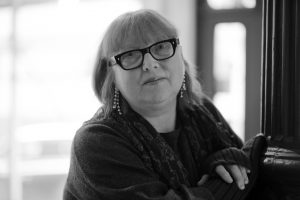
Photo by Nathan Rocky @nathanrocky
“I was always totally interested in these things that are new that I don’t know. ‘How do I learn?’ And it’s not technical skills. I have incredibly poor technical skills. But conceptually trying to understand how certain things work; how people think. I come from this generation where this lady in the East Village builds me a computer box. Right now the artists I deal with are born with the mouse in their hand. They are born with the games. It’s a very very different generation. If you look historically, galleries usually have this glory moment. The dealer or the gallerist understands the artists because they share the time. I don’t have that anymore. I would be showing 60-year-old people here.”
And you have to stay fresh.
“You have to, because this is a business in which it’s a moving target. You sit down, you’re out of it. I don’t sit down because it interests me not to sit down; see the next thing and figure out how this new generation of people thinks and what they do. It’s interesting. If I stop the game’s over. Then I can be like any other businessperson that enters the market on this transactional level — secondary market and selling things that are known and familiar. There’s nothing wrong with that. Very intelligent, very smart, very lovely people do that.”
But it’s not your interest.
“It’s not.
And being interested helps you stay current—
“It gives you a sense of current — between seeing all these extreme ends of what is a creative practice right now, and also being informed about the world. Because I think it’s a huge problem that a lot of art is done in a vacuum. People don’t know what goes on. I have no desire to impose my worldview on people. I’m not here to tell other people how they should operate, but we have this incredible luxury — this place that allows us to operate this way. Yeah, this is my world.”
Get Deviation Issue 002 (Print or Digital)
[fbcomments width="100%" num="10" ]

